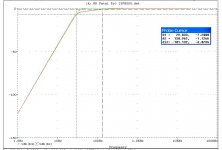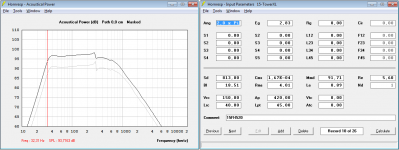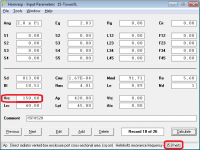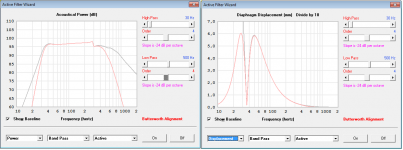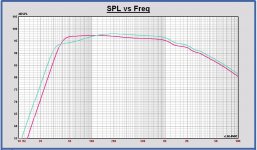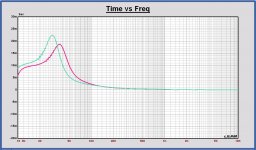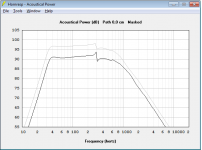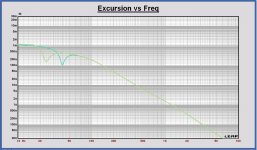But F3 higher than 40 Hz I suppose, Qts = 0.31 for that driver, so the basreflex aligment is more damped for same cabinet volume.
With the Faital 15FH520, a B4 aligment can be realized, with F3 = 40Hz.
With the Faital 15FH520, a B4 aligment can be realized, with F3 = 40Hz.
In halfspace it has f6 at ca 30hz (just under 27hz if you count 0db as 131hz/97db/2.83v). Not unrealistic.
It is what I would have chosen, if I needed another 15" sub.
It is what I would have chosen, if I needed another 15" sub.
Kaffimann,
You choose for a volume of about 150 L and a tuning frequency around 32 Hz for the 15FH500. Then you realize a slow fall off starting at about 200 Hz. Like the red figure in the plot below. It is more damped than a B4 around the tuning frequency fB. The green curve is a B4 response with the same low frequency response. So you can see your alignment is more damped and has a lower GD.
You prefer more such one, I know 🙂. I have no problem with it, it is a choice one must make to choose for a higher F3 but a lower F6 and F10 and a lower GD.
You choose for a volume of about 150 L and a tuning frequency around 32 Hz for the 15FH500. Then you realize a slow fall off starting at about 200 Hz. Like the red figure in the plot below. It is more damped than a B4 around the tuning frequency fB. The green curve is a B4 response with the same low frequency response. So you can see your alignment is more damped and has a lower GD.
You prefer more such one, I know 🙂. I have no problem with it, it is a choice one must make to choose for a higher F3 but a lower F6 and F10 and a lower GD.
Attachments
Last edited:
Noone has considered the Faital 15FH500[/URL]?
I suggest the 15FH520
FaitalPRO | LF Loudspeakers | 15FH520
Black - Half space
Gray - full space
Attachments
Is that in a cabinet of 150 L and tuned at 40 Hz? The Faital 15FH520 and the Ciare 15FXE-4 are almost identical.
Last edited:
for this raw simulation Vb=150 and Fb =35,8HzIs that in a cabinet of 150 L and tuned at 40 Hz?
I'm attaching the excell sheet so you can manipulate, take TSP, and also if you can redo all simulation it may worth the time spent to find more drive options before the new final decision. Using Hornresp it takes less then 5min per drive. you can also add filter if you want. see also tab Graphic in the attachment
The simulation above with filter on HP and LP 4th order.for this raw simulation Vb=150 and Fb =35,8Hz
Attachments
Well looks like Ciare FXE15-4 and Faital Pro 15FH520, have almost identical results in same size cab and both have same price range, so unless there s a difference somewhere else let s just pick one 🙂
KIM that my cals show that 15FH520 is around 95db not 98.
KIM that my cals show that 15FH520 is around 95db not 98.
In halfspace it has f6 at ca 30hz (just under 27hz if you count 0db as 131hz/97db/2.83v). Not unrealistic.
It is what I would have chosen, if I needed another 15" sub.
Kaffimann,
I looked in more detail to your basreflex proposal versus a Butterworth B4 basreflex alignment. I have compared the Faital 15FH500 and the Faital FH520 both in a 150 L cabinet. The Faital 15FH500 tuned at 32 Hz (your proposal) and the Faital FH520 at 40 Hz (B4). In the plots the SPL and the group delay of both in half space. The green curve is the 15FH500, the red one the 15FH520.
You can see the difference in SPL as expected. The group dealy of your proposal is lower above 35 Hz but becomes higher below 35 Hz.
It is a choice. Remark that with your proposal the SPL will decrease already below 150 Hz to keep the same sensitivity for the total speaker.
As an info, the SPL above 200Hz is not yet correct for these driver models.
Attachments
I'm attaching the excell sheet so you can manipulate, take TSP, and also if you can redo all simulation it may worth the time spent to find more drive options before the new final decision. Using Hornresp it takes less then 5min per drive. you can also add filter if you want.
see also tab Graphic in the attachment
Thanks. For my current simulations I use now the transfer as described in the AES article “Vented-box Loudspeaker Systems” by R.Small, one of the references.
I am more familiar with that now 🙂.
Last edited:
KIM that my cals show that 15FH520 is around 95db not 98.
It's all about space. if you check the input scree shared in the post #185 you will see 2pi (half space) indicated in the top left.
new attachment with space comparison for mentioned driver
Black = half space (2pi)
gray = full space (4pi)
Attachments
is this the sim you did for Ciare in post #174?
Is this a question for me? I don't understand it 🙂
It's all about space. if you check the input scree shared in the post #185 you will see 2pi (half space) indicated in the top left.
new attachment with space comparison for mentioned driver
Black = half space (2pi)
gray = full space (4pi)
Thanks for clarification 🙂 but i meant 15FH520 cals shows that it is rather around 95db (1W/1m) and not 98db, but i might be wrong will re check again 😉
Is this a question for me? I don't understand it 🙂
never mind I got it 🙂
I like the 15FH520 better than the FH500.
all three drivers Ciare FXE15-4, Faital Pro 15FH520 and Faital Pro 15FH500 have almost same f3 in same size box (150 L, Fb 38Hz).
Ciare FXE15-4 =36Hz
Faital Pro 15FH520 =37Hz
Faital Pro 15FH500 =37Hz
Ciare and 520 align almost identical but FH500 does not align w b4. Faital Pro 15PR400 fell behind 😀
Ciare is about 40$ cheaper here but Faital I believe is more available world wide and also has higher sensitivity.
my vote is still Ciare (since it is identical and cheaper 😀).
please lets see your vote so we can jump ahead to next step.
Paul can you please confirm the sims so I can update the first post (f3, cab size and sensitivity for 3 mentioned drivers)?
all three drivers Ciare FXE15-4, Faital Pro 15FH520 and Faital Pro 15FH500 have almost same f3 in same size box (150 L, Fb 38Hz).
Ciare FXE15-4 =36Hz
Faital Pro 15FH520 =37Hz
Faital Pro 15FH500 =37Hz
Ciare and 520 align almost identical but FH500 does not align w b4. Faital Pro 15PR400 fell behind 😀
Ciare is about 40$ cheaper here but Faital I believe is more available world wide and also has higher sensitivity.
my vote is still Ciare (since it is identical and cheaper 😀).
please lets see your vote so we can jump ahead to next step.
Paul can you please confirm the sims so I can update the first post (f3, cab size and sensitivity for 3 mentioned drivers)?
Last edited:
Paul:
Your simulation does not coincide with mine, I wonder what the difference between the software is... Does LEAP take into account the distances of the driver, walls and port in relation to each other?
Anyway, many ported enclosures will have the highest point of GD around tuning frequency, this is often also the point of acoustic impedance spike, and many ported enclosures give very little to no sound below the acoustic impedance spike.
Another thing to consider is that: to have higher fidelity of sound reproduction at 40hz you should avoid having the tuning frequency there, because group delay is more audible the higher the frequency, and also the previous point that there will be a dramatic reduction in sound output below tuning frequency.
One of the criteria of the design goals was to have a deep bass response, this is another reason for choosing a lower frequency tuning, some good piano recordings have a lot of output to 26-27hz (at least in my music collection). Most (do read: MOST, there are exceptions to everything) "Bass heavy" tunes have very little to nothing at all under 35hz though. So having a lower GD to the point of 30z is important to me, because that is how deep a lot of my music goes. Good natural bass players can have some content to 37hz, but very little under this other than ambience effects. House music and Techno often have very little under 40hz (or even 50hz!) also.
Here is a link to one of Claus Futtrup's documents regarding ported enclosures, he writes something about group delay there on page 15 onwards. http://www.cfuttrup.com/Book_05_Futtrup.pdf
But I will not argue my point any more, it is wasteful of people's time to read my wall of text raving nonsense. ;-)
Edit:
LordSansui: Just a small generalization from my side. You should try to avoid having a hump in frequency response at tuning frequency, it will sound much worse than if it is ruler flat or smooth/softer "knee".
Your simulation does not coincide with mine, I wonder what the difference between the software is... Does LEAP take into account the distances of the driver, walls and port in relation to each other?
Anyway, many ported enclosures will have the highest point of GD around tuning frequency, this is often also the point of acoustic impedance spike, and many ported enclosures give very little to no sound below the acoustic impedance spike.
Another thing to consider is that: to have higher fidelity of sound reproduction at 40hz you should avoid having the tuning frequency there, because group delay is more audible the higher the frequency, and also the previous point that there will be a dramatic reduction in sound output below tuning frequency.
One of the criteria of the design goals was to have a deep bass response, this is another reason for choosing a lower frequency tuning, some good piano recordings have a lot of output to 26-27hz (at least in my music collection). Most (do read: MOST, there are exceptions to everything) "Bass heavy" tunes have very little to nothing at all under 35hz though. So having a lower GD to the point of 30z is important to me, because that is how deep a lot of my music goes. Good natural bass players can have some content to 37hz, but very little under this other than ambience effects. House music and Techno often have very little under 40hz (or even 50hz!) also.
Here is a link to one of Claus Futtrup's documents regarding ported enclosures, he writes something about group delay there on page 15 onwards. http://www.cfuttrup.com/Book_05_Futtrup.pdf
But I will not argue my point any more, it is wasteful of people's time to read my wall of text raving nonsense. ;-)
Edit:
LordSansui: Just a small generalization from my side. You should try to avoid having a hump in frequency response at tuning frequency, it will sound much worse than if it is ruler flat or smooth/softer "knee".
Last edited:
Kaffimann,
What you are proposing is also called an extended basreflex. There are many speaker manufacturers applying it, like Avalon for example. My experience is that extended basrellex sounds more like a closed box system and a B4 more boomy, extremely expressed. You have not to convince me, I play with closed box heavy fill.
Can you give with the cabinet volume and the tuning frequency you are using for the 15FH500? I read 164 L, but the tuning frequency?
I like to compare Faital 15FH500 and Faital 15FH520/Ciare FXE15-4 also tuned at lower frequency.
If we could choose one driver and make two proposals, in same volume but with 2 different port lengths. I think it is possible to make one X-over design for both (except the woofer RLC compensation filter will be different). In that way there can be choosen for the one or the other.
What you are proposing is also called an extended basreflex. There are many speaker manufacturers applying it, like Avalon for example. My experience is that extended basrellex sounds more like a closed box system and a B4 more boomy, extremely expressed. You have not to convince me, I play with closed box heavy fill.
Can you give with the cabinet volume and the tuning frequency you are using for the 15FH500? I read 164 L, but the tuning frequency?
I like to compare Faital 15FH500 and Faital 15FH520/Ciare FXE15-4 also tuned at lower frequency.
If we could choose one driver and make two proposals, in same volume but with 2 different port lengths. I think it is possible to make one X-over design for both (except the woofer RLC compensation filter will be different). In that way there can be choosen for the one or the other.
I do not think so much about tuning frequency, it is the resonant behaviour of all distances and volumes together. At any rate, all the numbers are in the hornresp sim posted previously. The port is 228.6 cm2 and 54.6cm long. Does LEAP account properly for port volume? I am not familiar with it.
You have to forgive me for not giving any specifics right now, far away from any kind of proper computer. Difficult to run simulations on a mobile phone.
Anyway, if my crude math skills function to some slight degree, the volumes should be cirka 152.488 liters for the "box compartment" itself and 12.48156 liters for the port, so total volume together is about 164.96956 liters, or 165 liters if you do not care about decimals.
You have to forgive me for not giving any specifics right now, far away from any kind of proper computer. Difficult to run simulations on a mobile phone.
Anyway, if my crude math skills function to some slight degree, the volumes should be cirka 152.488 liters for the "box compartment" itself and 12.48156 liters for the port, so total volume together is about 164.96956 liters, or 165 liters if you do not care about decimals.
I do not think so much about tuning frequency, it is the resonant behaviour of all distances and volumes together. At any rate, all the numbers are in the hornresp sim posted previously. The port is 228.6 cm2 and 54.6cm long. Does LEAP account properly for port volume? I am not familiar with it.
You have to forgive me for not giving any specifics right now, far away from any kind of proper computer. Difficult to run simulations on a mobile phone.
Anyway, if my crude math skills function to some slight degree, the volumes should be cirka 152.488 liters for the "box compartment" itself and 12.48156 liters for the port, so total volume together is about 164.96956 liters, or 165 liters if you do not care about decimals.
Thanks Kaffimann, this information is very helpful for me.
I did now a comparison study of the three proposed drivers in Leap.
In Leap the internal box compartiment volume and port volume are separated. They can be defined independent.
I did use also a port area of 228 cm2 area and 54.6 cm length.
With this port length Leap tells me that the tuning FB = 24.2Hz, and I also see it at the impedance dip there.
So, I have simulated first the three drivers in a cabinet of 152 L tuned at 24.2Hz, lets name it the extented basreflex.
And the three drivers in the same cabinet volume tuned at 40 Hz, lets name that the B4 basreflex.
In the plots in attach:
- Faital 15H500 in red
- Faital 15H520 in green
- Ciare FXE 15-4 in blue.
The plots:
- SPL of the three drivers in a cabinet of 152 L and tuned at 24.2 Hz
- Groupdelay of the three drivers in a cabinet of 152 L and tuned at 24.2 Hz
these plots are in dark color
- SPL of the three drivers in a cabinet of 152 L and tuned at 40 Hz
- Groupdelay of the three drivers in a cabinet of 152 L and tuned at 40 Hz
these plots are in light color
- SPL of the three drivers in a cabinet of 152 L and tuned at 24 and 40 Hz in one plot
- Groupdelay of the three drivers in a cabinet of 152 L and tuned at 24 Hz and 40 Hz in one plot
As a first conclusion:
- there is not so much difference between the drivers for both extended and B4 concepts.
- IMO the Faital 15H520 is the best choice to use for both extended and B4.
- I think it is possible to implement both concepts in the project.
- for sure these two concepts will sound different. I agree with Kaffimann's arguments to use extended basreflex and how he describes the difference in post #195.
- remark that at 20 Hz, the SPL of the extended basreflex is 14 dB higher than the B4 version.
Enough stuff to think and discuss about 🙂
Attachments
-
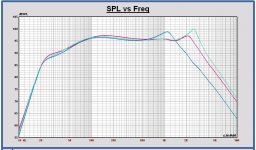 SPL three drivers VB = 152L FB = 24Hz.JPG144.7 KB · Views: 258
SPL three drivers VB = 152L FB = 24Hz.JPG144.7 KB · Views: 258 -
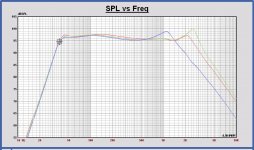 SPL three drivers VB = 152L FB = 40Hz.JPG142.4 KB · Views: 252
SPL three drivers VB = 152L FB = 40Hz.JPG142.4 KB · Views: 252 -
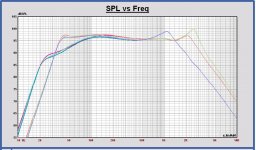 SPL three drivers VB = 152L FB = 24Hz and FB = 40Hz.JPG145.9 KB · Views: 247
SPL three drivers VB = 152L FB = 24Hz and FB = 40Hz.JPG145.9 KB · Views: 247 -
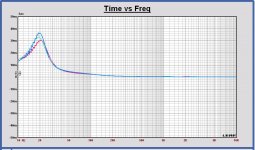 GD three drivers VB = 152L FB = 24Hz.JPG135.8 KB · Views: 268
GD three drivers VB = 152L FB = 24Hz.JPG135.8 KB · Views: 268 -
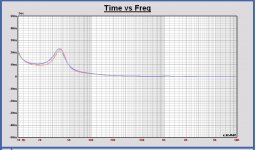 GD three drivers VB = 152L FB = 40Hz.JPG140.5 KB · Views: 97
GD three drivers VB = 152L FB = 40Hz.JPG140.5 KB · Views: 97 -
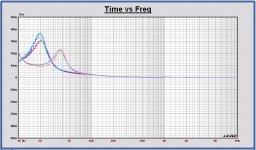 GD three drivers VB = 152L FB = 24Hz and FB = 40Hz.JPG142.8 KB · Views: 101
GD three drivers VB = 152L FB = 24Hz and FB = 40Hz.JPG142.8 KB · Views: 101
Paul,
Tunning port much lower then Fs would increase the diaphragm displacement making the driver reaching Xmax with much less power. Do you mind to make this comparisson?
Less GD with higher displacement wouldn't result in higher distorssion?
Tunning port much lower then Fs would increase the diaphragm displacement making the driver reaching Xmax with much less power. Do you mind to make this comparisson?
Less GD with higher displacement wouldn't result in higher distorssion?
Paul,
Tunning port much lower then Fs would increase the diaphragm displacement making the driver reaching Xmax with much less power. Do you mind to make this comparisson?
Less GD with higher displacement wouldn't result in higher distorssion?
You have a point yes. Maximum SPL and required amplifier power at maximal excursion will be investigated in the concept study, I will do soon.
fB is choosen now 24 Hz (conform Kaffimann's proposal) and 40 Hz for a B4. Maybe there are also more optimal solutions between.
Edit:
I had a quick look already at the excursion for fB = 24 vs. 40 Hz for the Ciare at 2.83 Vrms.
In the plot, the dark green curve is for 40 Hz and the light green for 24 Hz.
- fB = 40 Hz --> maximum excursion at 57 Hz, 463 um peak
- fB = 24 Hz --> maximum excursion at 39.6 Hz, 583 um peak
That is a factor 1.26 more excursion at 2.83 Vrms. In other words we can play 2 dB less hard.
The maximum SPL will decrease from about 117dB at 1m to 115 dB, still very hard 🙂.
Attachments
Last edited:
- Home
- Loudspeakers
- Multi-Way
- Open Source "Tower XL"
